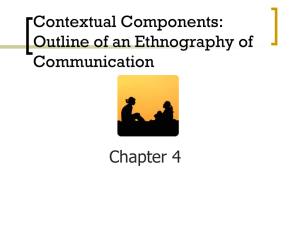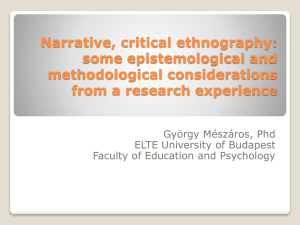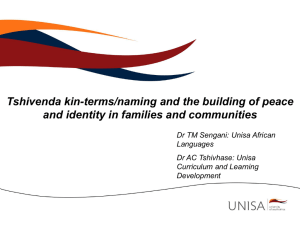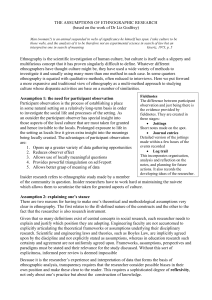Ethnography as Art Science and Survival Skill
advertisement
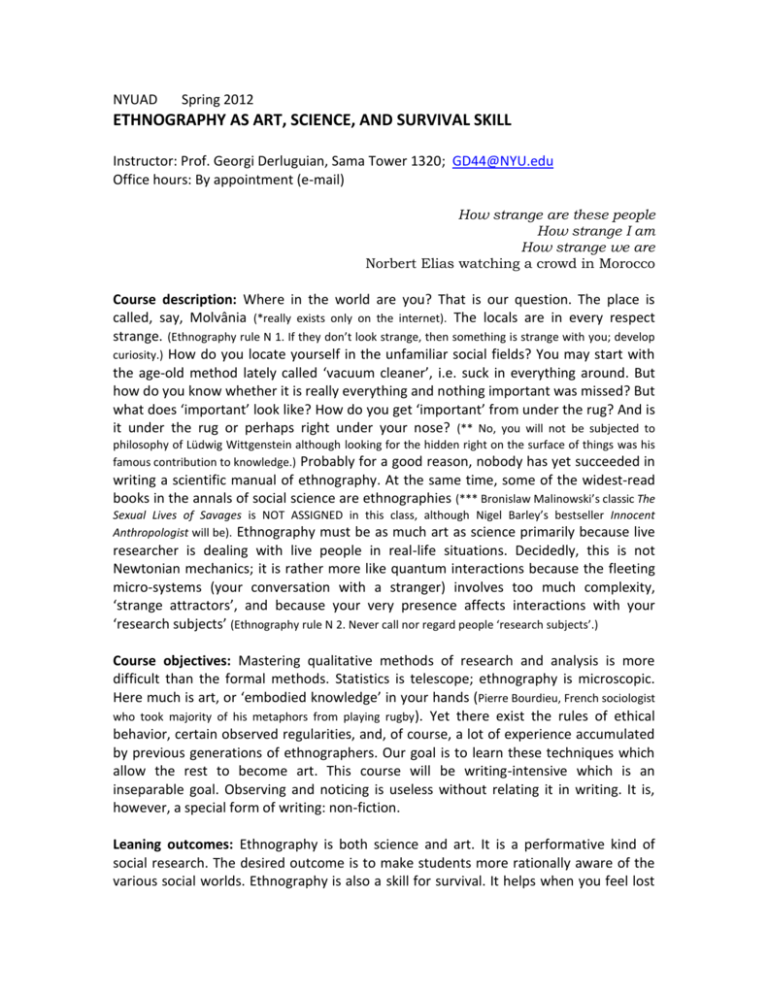
NYUAD Spring 2012 ETHNOGRAPHY AS ART, SCIENCE, AND SURVIVAL SKILL Instructor: Prof. Georgi Derluguian, Sama Tower 1320; GD44@NYU.edu Office hours: By appointment (e-mail) How strange are these people How strange I am How strange we are Norbert Elias watching a crowd in Morocco Course description: Where in the world are you? That is our question. The place is called, say, Molvânia (*really exists only on the internet). The locals are in every respect strange. (Ethnography rule N 1. If they don’t look strange, then something is strange with you; develop curiosity.) How do you locate yourself in the unfamiliar social fields? You may start with the age-old method lately called ‘vacuum cleaner’, i.e. suck in everything around. But how do you know whether it is really everything and nothing important was missed? But what does ‘important’ look like? How do you get ‘important’ from under the rug? And is it under the rug or perhaps right under your nose? (** No, you will not be subjected to philosophy of Lüdwig Wittgenstein although looking for the hidden right on the surface of things was his famous contribution to knowledge.) Probably for a good reason, nobody has yet succeeded in writing a scientific manual of ethnography. At the same time, some of the widest-read books in the annals of social science are ethnographies (*** Bronislaw Malinowski’s classic The Sexual Lives of Savages is NOT ASSIGNED in this class, although Nigel Barley’s bestseller Innocent Anthropologist will be). Ethnography must be as much art as science primarily because live researcher is dealing with live people in real-life situations. Decidedly, this is not Newtonian mechanics; it is rather more like quantum interactions because the fleeting micro-systems (your conversation with a stranger) involves too much complexity, ‘strange attractors’, and because your very presence affects interactions with your ‘research subjects’ (Ethnography rule N 2. Never call nor regard people ‘research subjects’.) Course objectives: Mastering qualitative methods of research and analysis is more difficult than the formal methods. Statistics is telescope; ethnography is microscopic. Here much is art, or ‘embodied knowledge’ in your hands (Pierre Bourdieu, French sociologist who took majority of his metaphors from playing rugby). Yet there exist the rules of ethical behavior, certain observed regularities, and, of course, a lot of experience accumulated by previous generations of ethnographers. Our goal is to learn these techniques which allow the rest to become art. This course will be writing-intensive which is an inseparable goal. Observing and noticing is useless without relating it in writing. It is, however, a special form of writing: non-fiction. Leaning outcomes: Ethnography is both science and art. It is a performative kind of social research. The desired outcome is to make students more rationally aware of the various social worlds. Ethnography is also a skill for survival. It helps when you feel lost in data or in unfamiliar country. Besides, unlike statistics, it might provide good conversation topics. All socially competent people have to be spontaneous ethnographers. Why not then try doing it more consciously? Teaching method and assignments. A very diverse range of teaching methods will be used: lectures, seminars, film discussion, student presentations, master class, field trips. We start with a few founding texts. This is a more conventional part in this course. The first assignment will be a take-home paper relating your readings to the French film Germinal which provides a stereoscopic and realistic picture of conflict. Ethnography, however, means being enterprising. It also protects you (‘I am not just bugging others, I am doing Ethnography here!’) The second assignment is already a ‘lab’ consisting of two parts: interviewing your fellow students or professors about the trajectory that temporarily brought them into Sama Tower, and observing people at a shopping mall, beach, the airport, or (things get smelly) the fish market. You write a reasonably short two-part report and in the process learn how the two kinds of ethnography are done. Each of the two parts in your second assignment is submitted and graded separately. The last assignment is also a report but this time more substantial and historically grounded. It will be a ‘world-systems biography’™ relating the story of a person(s) you have met to the context of their society. Conditions allowing, we will travel to one or two sites outside the UAE (possibly, Cairo and Yerevan) to do fieldwork during spring break or on a weekend. Grading: Active class participation is 25% of the final grade; the first assignment (on Germinal) is 15%; the second paper assignment — 15% for each of the two components; and 30% for the final paper. Writing matters in this class because ethnography is not only about human relations but also about relating. Required readings: – Norbert Elias, What Is Sociology? Translated from German. Columbia University Press, 1984. – Robert Emerson, Contemporary Field Research. Second edition. Waveland Press, 2001. – Robert Jackall, Moral Mazes: The World of Corporate Managers. Oxford University Press, 1988. – Georgi Derluguian, Bourdieu’s Secret Admirer in the Caucasus: A WorldSystems Biography. University of Chicago Press, 2005. Recommended: – Janet Abu Lughod, Cairo: 1001 Years of the City Victorious. Princeton, 1971; – Janet Abu Lughod, Rabat, Urban Apartheid in Morocco. Princeton, 1981. – Nigel Barley, The Innocent Anthropologist. Waveland Press, 2000. – Manuel Castells, The Rise of the Network Society. Volume I: The Information Age: Economy, Society, and Culture. Wiley, 2009, 2nd ed. – Class schedule Week I. The main question of sociology is WHY? Read Norbert Elias, What Is Sociology? Chapters 1 “The questions asked by Comte” and 2 “The sociologist as destroyer of myths”. Starting with the first week you are encouraged to begin observing and taking notes in the accessible public spaces like shopping mall, beach, the airport, stadium. Week II. The figurations of human societies. Read Norbert Elias, What Is Sociology? Chs 3 “Game models”, 4 “Universal features of human society”, 5 “Human interdependencies: affective, political, economic…” While chapter 6 “The problem of the ‘inevitability’ of social development" is not required, it is still very much recommended. Week III. Watching and noticing. Read first on the history of method “Introduction: The Development of Ethnographic Field Research” in Robert Emerson, Contemporary Field Research. Next is an influential classic Clifford Geertz, “Thick Description”. Finally, a short excerpt from D. Lawrence Wieder. “Telling the Convict Code”. All texts are found in Bob Emerson’s Contemporary Field Research, pp. 1 – 88. Week IV. Making sense. All readings for this week are in Emerson’s Contemporary Field Research. Start with another classic: “On Fieldwork” by Erving Goffman (pp. 153-158). Jump to pp. 317-334 where you find the ethnography classics, Howard Becker “The Epistemology of Qualitative Research” and Jack Katz “Analytic Induction Revisited” (look up what is epistemology or induction in a dictionary or online). Week V. Relating. Film: Germinal (France, 1994) and here comes THE FIRST ASSIGNMENT Due on February 26. You must write a 10-page report about what is going on in this epic film, at its many levels of class and professional occupation (industrialists, medical doctors and engineers, the bar- and shopkeepers, machinists and common proletarians), the world economic crisis or French national politics and army affecting the locality (coalmine town), and not least of all gender (you will see in action very different women). Use everything you have learned so far: Norbert Elias on figurations approach; the techniques of ‘thick description’ and methodological validation (i.e., do all workers in Germinal behave like classconscious proletarians? If not, why?) In writing this assignment you should rely on Paul Atkinson’s essay “Ethnography and the Representation of Reality” (pp. 89-101 in Emerson’s Contemporary Field Research) Week VI. Learning from doing it. Read Robert Jackall, Moral Mazes: The World of Corporate Managers. You have to read the whole book over this and the following week. Take notes. Start preparing for the second assignment. It has two components: observing a public place (street corner, fish market, shopping mall, bus station, cinema, etc.) and interviewing your fellow students about the life-trajectories that brought them here. Report and discuss in class your difficulties, doubts, successes. Take inspiration in the funny and insightful bestseller of Nigel Barley, The Innocent Anthropologist: Notes from a Mud Hut. (Highly recommended) Week VII. Observing, Interviewing, and Connecting. Continue reading the required Robert Jackall’s Moral Mazes and (recommended) Innocent Anthropologist. As you are doing further interviews and observations, you might and perhaps should want to revisit at this point Bob Emerson’s collection Contemporary Field Research, both what we have already read and what is still remaining there as recommended, esp. the chapters by Mitchell Duneier, Dorinne Kondo, Barrie Thorne, and (hope you would not need it in practice, but perhaps exactly for this reason nevertheless read) Richard Leo on his “Trial and Tribulations.” Week VIII. THE SECOND ASSIGNMENT Part I: OBSERVATIONS IN PUBLIC PLACES is due March 4. This assignment comes in two installments, each graded separately. First, you write a 10-page based on your observations. This report is due in class in the beginning of week VIII and we spend our second meeting of this week as a seminar to discuss your successes, failures, necessary improvements. No specifically assigned readings but you must complete all your previous reading assignments. Week IX. THE SECOND ASSIGNMENT Part II: INTERVIEWS WITH FELLOW STUDENTS (yes, including in your class). Another 10 pages, graded separately. The procedure remains the same: you submit the papers which we discuss in the second meeting of this week. Due March 11. Week X. Seeing global in the local. Read Immanuel Wallerstein’s short essay “Sociology for the Undergraduates” (especially the critique of “Street-corner Society”) and Bourdieu’s Secret Admirer in the Caucasus, Ch. I “The Field”. Week XI. Global connections made in the local interactions. Read Bourdieu’s Secret Admirer in the Caucasus, Ch. 4 “from 1968 to 1989” and Ch. 5 “Social structure”. Recommended wholeheartedly: Janet Abu Lughod, Cairo: 1001 Years of the City Victorious. (Princeton, 1971) and her Rabat, Urban Apartheid in Morocco. (Princeton, 1981). Week XII Extreme ethnography, or how to study war and revolution. Read Bourdieu’s Secret Admirer in the Caucasus, Ch. 6 “The Nationalization of Provincial Revolutions” and Ch. 7 “The Scramble for Soviet Spoils”. Weeks XII and XIV are reserved for discussing, debating, refining the knowledge obtained in fieldtrips. We can also schedule group and individual consultations on writing the final assignment. FINAL REPORTS (incorporating your theoretical knowledge and practical observations) ARE DUE NO LATER THAN THE LAST DAY OF EXAMINATION WEEK: 16 May 2012. No page limit.

